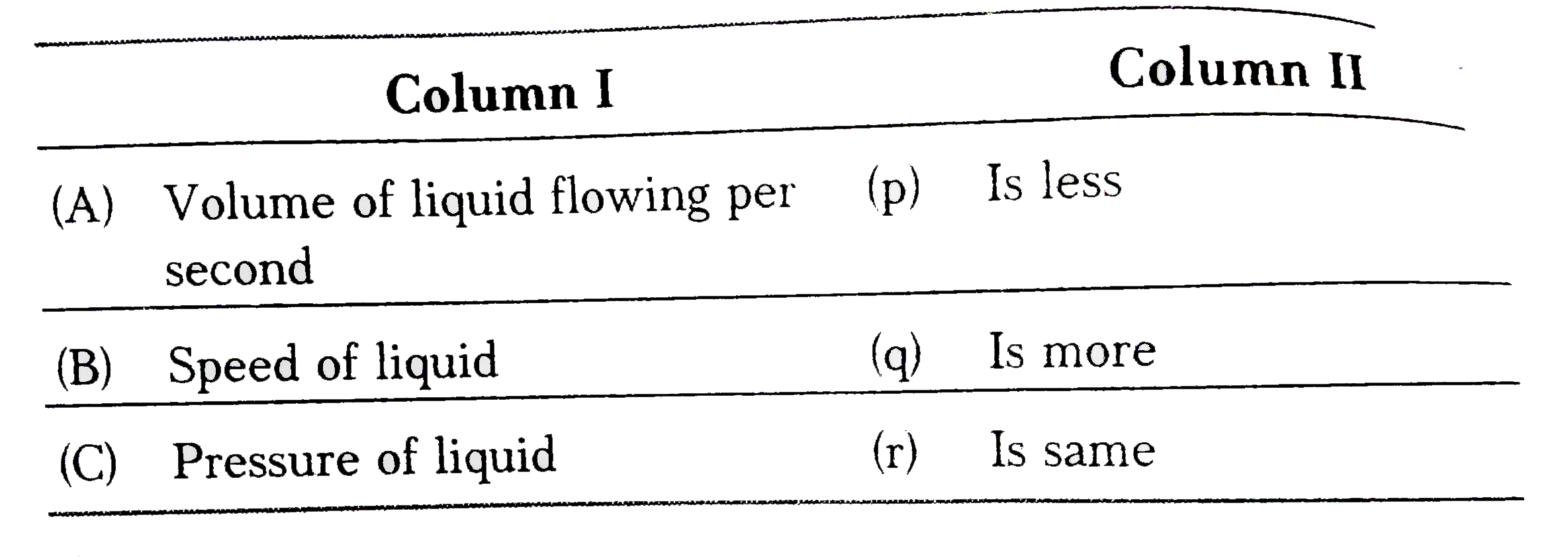Water coming out of the mouth of a tap and falling vertically in streamline flow forms a tapering column, i.e., the area of cross-section of the liquid column decreases as it moves down. Which of the following is the most accurate explanation for this ?
 .
.
As the water down, its speed increases and hence its pressure decreases. It is then compressed by the atmosphere.
Falling water tries to reach a terminal velocity and hence reduces the area of cross-section to balance upward and downward forces.
The mass of water flowing past any cross-section must remain constant. Also, water is almost incompressible. Hence, the rate volume flow must remain constant. As this is equal to velocity area, the area decrease as velocity increases.
The surface tension causes the exposed surface area of the liquid to decrease continuosly.
The correct Answer is:C
Topper's Solved these Questions
Similar Questions
_E01_111_Q01.png)
Water coming out of the mouth of a tap and falling vertically in stream line flwo forms a tapering column. i.e., the area of cross-section of the liquid column decreases as it moves down which of the following is the most accurate explanantion for this-
View Solution_E01_111_Q01.png)
Water coming out of the mouth of a tap and falling vertically in stream line flwo forms a tapering column. i.e., the area of cross-section of the liquid column decreases as it moves down which of the following is the most accurate explanantion for this-
View Solution
Knowledge Check
In the previous question, at the mouth of the tap the area of cross-section is 2.5cm2 and the speed of water in 3m/s. The area of cross-section of the water column 80cm below the tap is.
A2cm2B1.5cm2C1cm2D0.5cm2While going down in the group of non-metals (14, 15, 16 and 17) the electronegative character of non-metals decreases. Typical example is of group 15 elements. The elements nitrogen (2nd period) and phosphorus (3rd period) are non-metals and their oxides are acidic in nature. The elements arsenic (4th period) and antimony (5th period) are metalloids and their oxides are amphoteric in nature. However, bismuth (6th period) is a metal. Thus, we can see that the electronegative character (non-metallic character) of elements gradually decreases and ultimately the last element becomes metal. In case of group 17 of halogens, the first member of the group i.e., fluorine is most non-metallic in character and last member of group, i.e., astatine is least non-metallic in character. In other words, the electronegative nature of the elements decreases as we move down the group.
Which of the following is the most metallic element?APBNCBiDAsWhile going down in the group of non-metals (14, 15, 16 and 17) the electronegative character of non-metals decreases. Typical example is of group 15 elements. The elements nitrogen (2nd period) and phosphorus (3rd period) are non-metals and their oxides are acidic in nature. The elements arsenic (4th period) and antimony (5th period) are metalloids and their oxides are amphoteric in nature. However, bismuth (6th period) is a metal. Thus, we can see that the electronegative character (non-metallic character) of elements gradually decreases and ultimately the last element becomes metal. In case of group 17 of halogens, the first member of the group i.e., fluorine is most non-metallic in character and last member of group, i.e., astatine is least non-metallic in character. In other words, the electronegative nature of the elements decreases as we move down the group.
Which of the following is the most non-metallic element?AFBClCBrDI
A liquid is flowing through a pipe of non-uniform cross-section. At a point where area of cross-section of the pipe is less, match the following columns.

View SolutionA liquid is flowing through a pipe of non-uniform cross-section. At a point where area of cross-section of the pipe is less, match the following columns.

View SolutionIf water falls from a tap, then the volume rate of flow of water at depth of h, (A0 is the area of cross-section of the mouth and A02 is the corresponding area at depth h)
View SolutionWater from a tap of cross sectional area 1cm2 starts falling down vertically, with a speed of 1m/s. What is the area of cross section of the stream of water at a distance of 20cm below the mouth of the tap?
[Assume that (1) the flow is steady, (2) pressure is constant throughout the stream of water and g=10m/s2]
View SolutionIf water falls from a tap, then the volume rate of flow of water at depth of h, (A0 is the area of cross-section of the mouth and A02 is the corresponding area at depth h)
View Solution
